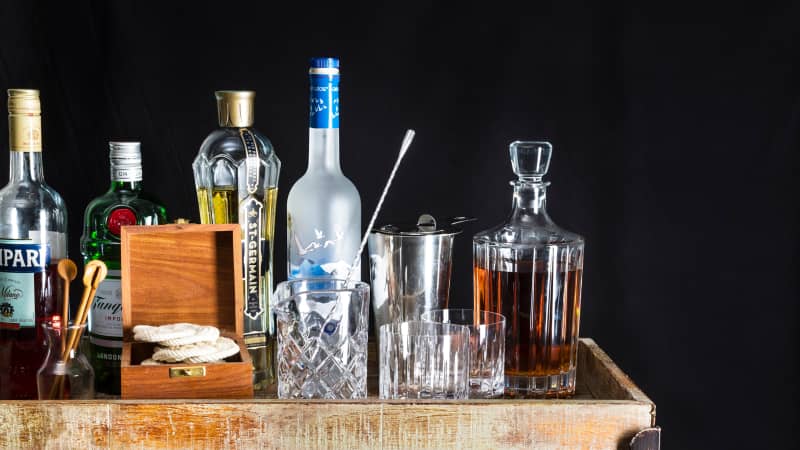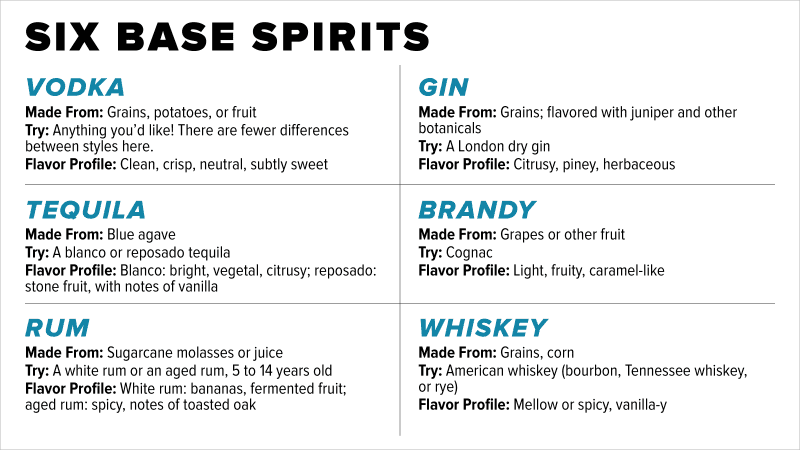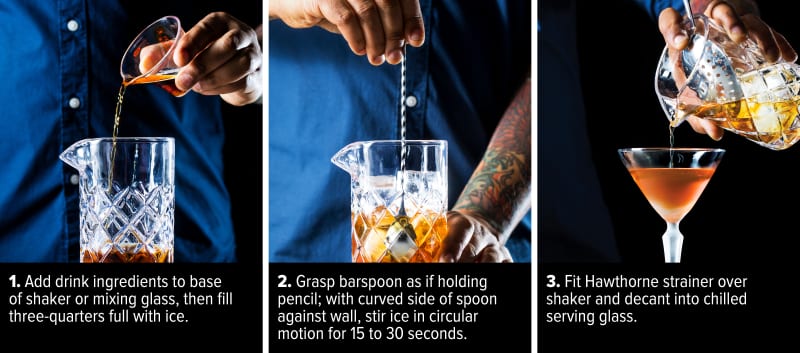Mixing a drink is pretty similar to cooking a dish: For the best results, you need good ingredients, good equipment, and a good recipe. If you’ve never made a cocktail before, this guide will give you all the information you’ll need to get started. And if you’ve already been making drinks for a while, you might find something that will allow you to improve your technique or expand your repertoire. By adding to your collections of spirits, barware, glassware, and recipes, you can bring your cocktail-making expertise to a new level.
Home Bartending 101
Published Aug. 14, 2020.

Spirits and Other Ingredients
By using these core ingredients in different combinations and proportions, you can make a wide variety of cocktails. Quality matters, but we recommend saving your very best spirits for sipping on their own. For making cocktails, we prefer to use bottles that are more moderately priced, from $15 to $40. And while many types of each spirit exist, we’ve highlighted the specific kind or kinds we recommend buying, where applicable, because we feel that they are the most versatile and appropriate versions for the broadest range of cocktails.

Other Ingredients
Two Vermouths
Dry Vermouth, ATK Recommends: Dolin Dry Vermouth de Chambéry
Sweet Vermouth, ATK Recommends: Cinzano Rosso Vermouth or Cocchi Storico Vermouth di Torino
Two Liqueurs
Cointreau: An orange-flavored liqueur
Campari: An intensely bittersweet aperitif with a distinctive red color
Two Bitters
Angostura Bitters: Concentrated digestif flavored with bitter herbs and warm spices
Orange Bitters: Digestif with bright, citrusy flavor
Mixers
Seltzer, ATK Recommends: Polar Original Seltzer
Tonic Water, ATK Recommends: Polar Premium Tonic Water
Fruits for Fresh Juice: Lemon, lime, grapefruit
Garnishes: Olives, maraschino cherries, citrus peels
Other Spirits to Expand Your Collection
Additional Base Spirits: Other types of gin, rum, and whiskey; mezcal, sake, shōchū, Scotch whiskey, cachaça, and more
Fortified Wines
Additional Liqueurs, Aperitifs, Digestifs, and Fortified Wines: Chartreuse, maraschino, Lillet Blanc, Aperol, Amari, Cynar, Sherry, Port, Eaux de Vie
Barware
A few basic pieces of equipment make the processes of measuring, shaking, stirring, and serving cocktails much easier, neater, and more efficient.

Cobbler Shaker
Easy for novices to use
ATK Recommends: Tovolo Stainless Steel 4-in-1 Cocktail Shaker
Winning Traits
- Leakproof
- Easy to open, fill, and seal
- Large capacity

Boston Shaker
Requires a little more experience to seal properly but is ultimately simpler and more foolproof to use and clean
ATK Recommends: The Boston Shaker Professional Boston Shaker, Weighted
Winning Traits
- Leakproof
- With practice, easier and quicker to open, fill, and seal
- Large capacity
- Easier to clean

Hawthorne Strainer
For straining finished cocktails into glasses; holds back ice and muddled ingredients
ATK Recommends: Cocktail Kingdom Koriko Hawthorne Strainer
Winning Traits
- Closely spaced coils that filter out most ice and debris
- Wide wings that span even large shakers
- Short handle for better balance

Jigger
For accurately and easily measuring the small volumes of liquid used in cocktails
ATK Recommends: OXO Good Grips Angled Measuring Cup, Clear
Winning Traits
- Accurate, easy-to-read measurement lines
- Wide mouth for easy filling
- Neat

Barspoon
For stirring spirit-only drinks in tall shakers and retrieving olives and cherries from jars
ATK Recommends: Cocktail Kingdom Teardrop Barspoon
Winning Traits
- Good length for favorite shakers
- Twisted handle that is easy to grip and rotate
- Medium-size bowl that corrals ice, scoops garnishes, and layers cocktails well

Muddler
For muddling (pounding to express the essential oils of) herbs and citrus
ATK Recommends: Fletcher’s Mill Maple Muddler
Winning Traits
- Good height for favorite shakers
- Large head covers more ground quickly
- Good weight for ease of use without fatigue
- Easy and comfortable to hold

Manual Citrus Juicer
For juicing lemons, limes, and grapefruits
ATK Recommends: Chef’n FreshForce Citrus Juicer
Winning Traits
- Quickly and efficiently juices and drains citrus
- Easily accommodates citrus of different sizes
- Durable

Peeler
For making basic citrus-peel garnishes
ATK Recommends: Kuhn Rikon Original Swiss Peeler
Winning Traits
- Light but sturdy
- Razor-sharp blade
Next-Level Gear
- Cocktail Ice Cube Molds
ATK Recommends: OXO Good Grips Covered Silicone Ice Cube Tray - Large Cubes, Zoku Ice Ball Molds, True Cubes
- Handheld Smoke Infuser
ATK Recommends: Breville/Polyscience Smoking Gun Pro
- Home Seltzer Maker
ATK Recommends: SodaStream Source
- Channel Knife/Citrus Zester
ATK Recommends: Messermeister Pro-Touch Combination Zester
- Mixing Glass
- Small Fine-Mesh Strainer

Glassware
The right glassware can elevate the presentation of your drink. These glasses are the most useful and versatile for serving cocktails.

Old-Fashioned (Rocks) Glass
For stirred drinks (either “neat”—with no ice—or “on the rocks”—with ice) and for shaken cocktails served on the rocks
Size: 8–12 ounces

Collins (Highball) Glass
For “long” drinks made with a spirit and a nonalcoholic mixer (soda, juice, etc.)
Size: 10–12 ounces

Martini or Coupe Glass
For cocktails that have been shaken and strained; both glasses are common and acceptable.
Size: 5–6 ounces
Shake or Stir?
As a rule of thumb, stir a cocktail that is made only of spirits, and shake a cocktail that includes juices, cream or milk, or egg whites. (For highballs—tall, iced drinks—with carbonated mixers, such as gin and tonics or vodka sodas, the carbonated mixer should be added to the spirit right before serving and very briefly stirred to combine without losing too many bubbles.)
Stirring and shaking effectively accomplish the same task, agitating the ice in the cocktail shaker so that the cocktail ingredients are chilled and diluted. Chilling and dilution go hand in hand; you can’t have one without the other, and both are important for good results. Dilution isn’t a bad word in this context; the water that melts off of the ice is essential for bringing the drink ingredients into harmony, toning down any acids and softening the alcohol content to a more palatable level.
That said, stirring and shaking yield finished drinks with very different textures. It takes longer to dilute and chill a drink to the proper levels by stirring, but the result is a clear, silky-smooth, spirit-forward cocktail. Shaking is much more efficient, thermodynamically speaking: Because you are forcing ice cubes to interact and collide dramatically with the drink ingredients (and each other), you can chill and dilute a drink much more quickly. And because of all that turbulence, shaken drinks have more body than stirred ones do, as air and minuscule particles of ice are incorporated into them.
How to Stir a Cocktail

How to Shake a Cocktail in a Cobbler Shaker

How to Shake a Cocktail in a Boston Shaker

How to Make a Twist
A simple twist is one of the prettiest and most versatile garnishes you can make for most cocktails—and one that can impart the drink with its scent, as well. While you can use a channel knife (citrus zester) to make these, a vegetable peeler and paring knife work just fine, too.

How to Muddle

To muddle, add ingredients to bottom of shaker and use muddler to pound them, turning muddler occasionally.
Our Classic Recipes
The following classic cocktails can all be made with the core ingredients listed above. Think of these cocktails as building blocks for other cocktails; by altering the type and volume of each ingredient, you can get very different drinks. To provide a sense of the options, we’ve included notable variations and alternatives for each drink where possible.







